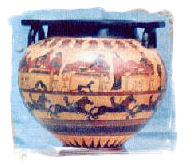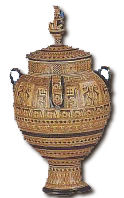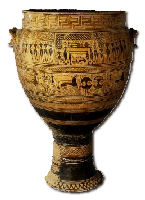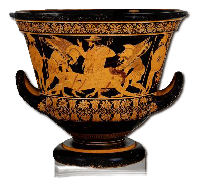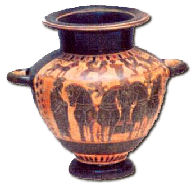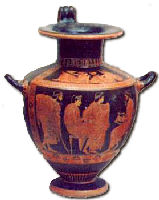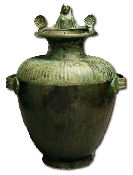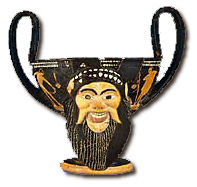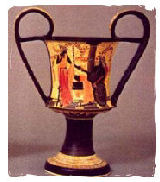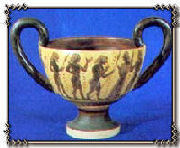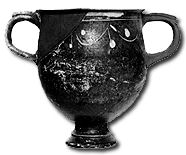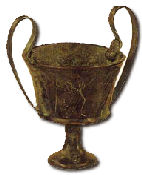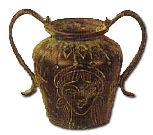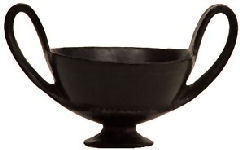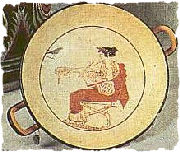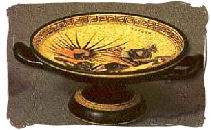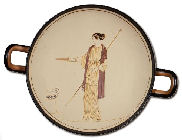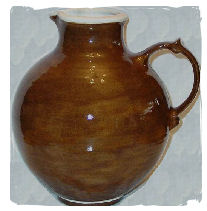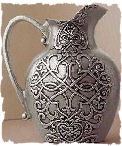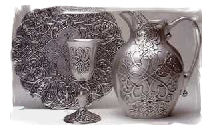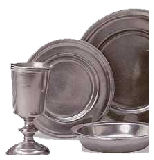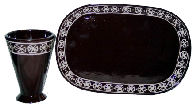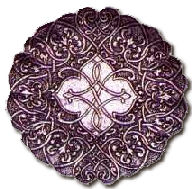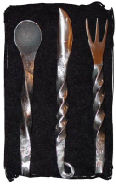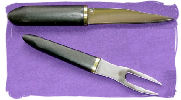Dining Customs
Eating and Drinking Vessels
No Silver?
Fallacy: Serving Ka-la-na or any wine or even Paga in a silver vessel will poison the drinker.
Fact: On Gor, drinking vessels are made of many things, such as, gold, silver and pewter. Serving Ka-la-na or any wine or alcoholic beverage in a metal vessel is perfectly acceptable, and absolutely does not taint the wine, as evidenced by the following quotes. Note that in the last quote, wines are served in goblets, though it does not state what the goblets are made of. However, based on the first quote, it's reasonable that the goblets were metallic, rather than ceramic. As a side note, however, Ka-la-na is traditionally served from the crater rather than a goblet.
""My hand clenched on the metal goblet. The wine moved in the vessel." — Tarnsman of Gor, page 30.
"I thrust out the silver Paga goblet, studded with rubies, and Telima, standing beside my thronelike chair, filled it. I did not look upon her." — Raiders of Gor, page 223.
"One girl held our head back, and others, from goblets, gave us of wines, Turian wine, sweet and thick, Ta-wine, from the famed Ta grapes, from the terraces of Cos, wines even, Ka-la-nas, sweet and dry, from distant Ar." — Tribesmen of Gor, page 213.
"Bring me a goblet," I said. A goblet was fetched. It was of heavy gold. — Marauders of Gor, page 22.
How the notion of metal vessels tainting wine came about in virtual chat rooms can be blamed on misconceptions and lack of knowledge, or perhaps carried over from another roleplay genre.
Eating vessels were generally made of pewter or ceramic, although there were instances seen in which platters and plates were made of gold. Eating utensils varied in design by region. Serving trays were found made of wood as well. Cooking pots varied from small bowls to large kettles, again depending on region and culture.
Much of the vessels John Norman used in his books date back to Roman-Greco and Medieval times. I have done extensive research in gathering pictures, photographs and other historical information on these different items to enable the readers and role-players to actually "see" what it is they are drinking from, eating from, serving from, etc.
Serving vessels are commonly placed upside down on racks to prevent dust and dirt to collect on them. Woe be it to the slave who dared serve a dirty vessel!!
"Temione had now filled her Paga vessel. She picked up a goblet from a rack near the vat. The shelving on the rack was of narrow wooden rods. The goblets are kept upside down on the rods. In this way, washed, they can drain and dry. This also affords them some protection from dust. I watched her carefully wipe the goblet. Woe to the slave who would dare to serve Paga or wine in a dirty goblet!" — Vagabonds of Gor, page 20.
Common Serving and Drinking Vessels
Amphora
A two-handled narrow-necked vessel generally having a pointed base; not a serving vessel but is commonly buried in the earth, its neck above the earth, to keep its contents cool. 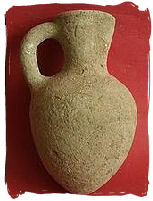 The amphora described in this passage from Mercenaries of Gor best fits the picture above of a seventh (7th) century BC Greek one-piece amphora [pictured].
The amphora described in this passage from Mercenaries of Gor best fits the picture above of a seventh (7th) century BC Greek one-piece amphora [pictured].
Etymology: Latin, modification of Greek amphoreus, amphiphoreus, from amphi- + phoreus bearer, from pherein to bear; Date: 14th century
"An ancient Greek jar or vase with a large oval body, narrow cylindrical neck, and two handles that rise almost to the level of the mouth." —Merriam-Webster Dictionary ©2003-2006
"It would have been stored overnight, I assumed, in an amphora, buried to the neck in the cool earth. Sometimes Earth girls, first brought to Gor, do not understand why so many of these two-handled, narrow-necked vessels have such a narrow, usually pointed base, for they cannot stand upright on such a base. They have not yet learned that these vessels are not intended to stand upright. Rather they are commonly fitted into a storage hole, buried there to keep their contents cool, the necks above the earth. The pointed base, of course, presses into the soft earth at the bottom of the storage hole." — Mercenaries of Gor, page 257.
[pictured: ca. 375-70 B.C.; Greek; Attributed to the Asteios Group; Ceramic, Attic black-figure ware; height 83.6 cm (33 in.)]
"One of the principal vessel shapes in Greek pottery , a two-handled pot with a neck narrower than the body. There are two types of amphora: the neck amphora, in which the neck meets the body at a sharp angle; and the one-piece amphora, in which the neck and body form a continuous curve. The first is common from the Geometric period (c. 900 BC) to the decline of Greek pottery; the second appeared in the 7th century BC. The height of amphorae varies from large Geometric vases of 5 feet (1.5 metres) to examples of 12 inches (30 centimetres) or even smaller (the smallest are called amphoriskoi). The average normal height is about 18 inches (45 centimetres). Amphorae, which survive in great numbers, were used as storage and transport vessels for olives, cereal, oil, and wine (the wine amphora was a standard Attic measure of about 41 quarts [39 litres]) and, in outsize form, for funerals and as grave markers. Wide-mouthed, painted amphorae were used as decanters and were given as prizes.
"The neck amphora, prefigured in Mycenean (14th-century-BC) pottery and remodelled as a main shape in the Protogeometric style (c. 1000-900 BC), has about 12 distinct shape variations, determined as much by utilitarian as by aesthetic considerations. Noteworthy are the Nolan type (from Nola, Italy), some of which had triple handles popular in red-figure pottery; the Panathenaic amphora, painted in black-figure and presented as a prize (filled with olive oil and having the inscription "I am one of the prizes from Athens") at the Panathenaic Festivals from the 6th to the 2nd century BC; and the loutrophoros, slender-bodied, with a tall neck and flaring mouth, used from the 6th century for ritual purposes at weddings and funerals. The one-piece amphora maintained a more consistent shape, with cylindrical handles, flaring lip, echinus foot, and amply curved belly. Amphorae, such as wine containers, continued to be made in profusion during the Roman Empire." — Encyclopaedia Britannica ©2003-2006
Bota
See also: "Talu Bag," "Skin Bag" and "Wineskin"
Skin bags, or botas, on Gor are made from the skins of an animal, such as the verr. There seem to be a variety of these skin bags, probably as to the region and culture in which they originate. The skins are stripped carefully of all dirt and fur, any tears are sewn and the seams are coated with wax. Some are plugged with a horn plug, some have spigot devices.
Why Leather and Not Animal Bladder?
My research on the subject of skin bags through various resources found the following.
Most importantly, leather has very unique properties. Most living creatures breathe through tiny pores in their skin, as well as through their nostrils. Tanned leather retains this property of breathing. Ancient man knew that water, milk or wine kept in a skin bag remained cool and fresh for a long time, however, they did not know why. Modern man knows now that it is due to the porous nature of leather. Even today, skin bags are still used in many hot climates around the world.
Based upon archaeological evidence, the Romans made great use of leather. Historical facts suggest that it was inexpensive and easily obtainable, as well as craftsmen were readily available. Also it would be easier for the legionnaires to learn basic leatherworking skills, thus allowing them to make and repair the simpler items of his equipment, in the field if necessary. Metals, on the other hand, would have to be mined and smelted and would probably have been very expensive in comparison, and the ability of legionnaires to work the metals very unrealistic.
When Jesus spoke of pouring wine into bottles, he was actually meaning of skin bottles. He reminded His listeners that when they bottled new wine, to be careful to use new bottles, which would stretch, thus allowing for fermentation to take place.
Heavy leather would be soaked in warm water, then shaped and stitched and allowed to dry. Once dry hot pitch would be poured into the vessel, swilled around then poured out and allowed to dry. This then made the vessel watertight. There are numerous examples in museums of water bottles and tankards being made using this method.
Animal bladders can be used for short term liquid containers. Because the characteristics of an animal bladder are very much like a balloon, as well as its thin construction, this causes several problems and the ability to apply any sort of tanning process to prevent decay is extremely difficult. Once the bladder is removed from the animal, the bladder has to be blown up, tied off and left for a few days to remove the stretch characteristic (if not done, the effect is like filling a balloon with water and then trying to drink from it). After the drying process, the bladder becomes stiff and needs to be soaked in warm water to make it pliable once again. Because of the delicacy of the bag, some sort of outer covering needs to be used to keep the bag from breaking, such as a net bag or leather bag. Dropping the bag inevitably would cause it to split. Also, the bag must continually be kept filled with liquid to prevent it from becoming hard and brittle. One would have to repeat the process of soaking it in warm water to return its pliancy. This however, makes the bag that much more delicate. Bladders are not pourous as is leather.
Water skins are made are generally made in one piece. The animal is skinned by working two of the feet out of the skin then it is just a simple matter of peeling the skin away. Th camel regiments in Egypt use water skins made from camel. These skins always seeped water; this seepage serving to keep the contents cool by the process of evaporation. Water skins used today by nomadic desert tribes and African herdsmen are made using techniques passed down through generations.
>The bota on the right is a curved traditional hand-made Bota (Wineskin) from Spain with a pitch lined interior. Las Tres Z.Z.Z. of Pamplona is one of the best known of the makers of fine botas in Spain. Each bota is made from flawless goat's hide which is cured with vegetable oils to make it pliable. Then the skin is cut and sewn by hand to make a tight pleating. Next, it is turned inside out and pitch is applied. Very short bristles of hair are left on the leather to hold the pitch for the inside of each bag. This is heated to create a water proof resin that will last for years. Finally, the bota is sewn together and the final touches are added. There are about forty (40) stages from the time the skin arrives and the wineskin is finished.
"Water," I said. He came to me, bent over, tattered, swarthy, grinning up at me, the verrskin bag over his shoulder, the brass cups, a dozen of them, attached to shoulder straps and his belt, rattling and clinking. His shoulder on the left was damp from the bag… One of the brass cups he unhooked from his belt. Without removing the bag from his shoulder, he filled the cup… The water flowed into the cup through a tiny vent-and-spigot device, which wastes little water, by reducing spillage, which was tied in and waxed into a hole left in the front left foreleg of the verr skin. The skins are carefully stripped and any rents in the skin are sewed up, the seams coated with wax. When the whole skin is thoroughly cleaned of filth and hair, straps are fastened to it so that it may be conveniently carried on the shoulder, or over the back, the same straps serving, with adjustment, for either mode of support. The cup was dirty. I took the water and gave the man a copper tarsk. — Tribesmen of Gor, page 36.
"Someone gave me a swallow of Paga from a leather bota." — Raiders of Gor, page 171.
"Drink," he said. He thrust the horn nozzle of a leather bota of water between my teeth. I almost choked. He withdrew the nozzle and capped the bota, replacing it in his saddle pack. — Captive of Gor, page 256.
Bottles
Glass vessels used for containing liquids.
"Also, I didn't want Kazrak, when his wound was healed, to be reduced to challenging some luckless warrior for a bottle of Ka-la-na wine." — Tarnsman of Gor, page 126.
"In most taverns no bottle is brought to the table but the Paga is brought to the table, by the Paga slave, a cup at a time, the cups normally being filled from a vat behind the counter." — Explorers of Gor, page 158.
Carafes / Black Wine Vessels
Metal vessels for holding hot drinks, such as black wine.
"On the tray, too, was the metal vessel which had contained the black wine, steaming and bitter, from far Thentis, famed for its tarn flocks, the small yellow-enameled cups from which we had drunk the black wine, its spoons and sugars…" — Explorers of Gor, page 10.
"From one side a slave girl, barefoot, bangled, in sashed, diaphanous, trousered chalwar, gathered at the ankles, in tight, red-silk vest, with bare midriff, fled to him, with the tall, graceful, silvered pot-containing the black wine. She was veiled. She knelt, replenishing the drink. Beneath her veil I saw the metal of her collar." — Tribesmen of Gor, page 88.
Crater
Also: "Krater"
Two-handled drinking vessel for the mixing and serving of wine. The crater dates back the Roman-Greco era in Earth history. Generally, wine is not drank directly from the crater, but is drank from the cylix (also, kylix). Perhaps John Norman got a bit mixed up. See: Kylix.
"Krater, or crater: A wide two-handled bowl used in ancient Greece and Rome." — American Heritage College Dictionary, Third Edition ©2001
"Krater, also spelled Crater, — ancient Greek vessel used for diluting wine with water. It usually stood on a tripod in the dining room, where wine was mixed. Kraters were made of metal or pottery and were often painted or elaborately ornamented. In Homer's Iliad the prize offered by Achilles for the footrace at Patroclus' funeral games was a silver krater of Sidonian workmanship." — Encyclopaedia Britannica ©2003-2006
Roman and Greek Craters Wine Crater, c. 660 BC "Heralces in the House of Eurytos"
Cycladic Geometric KraterKrater c. 750-735 BC Calyx Krater c. 515 BC
"Aphris got up and fetched not a skin, but a bottle, of wine, Ka-la-na wine, from the Ka-la-na orchards of great Ar itself. She also brought a black, red-trimmed wine crater from the isle of Cos… She poured wine into the crater… Then he threw back his head and drained the crater." — Nomads of Gor, pages 150-151.
"Serve me wine," I said. She did so, kneeling before me, head down, handing me the black, red-trimmed wine crater, that of the master… — Nomads of Gor, page 293.
"Give him Ka-la-na wine," prompted Elizabeth.
Aphris got up and fetched not a skin, but a bottle, of wine, Ka-la-na wine, from the Ka-la-na orchards of great Ar itself. She also brought a black, red-trimmed wine crater from the isle of Cos.
"May I serve you?" she asked. Kamchak's eyes glinted. "Yes," he said. She poured wine into the crater and replaced the bottle. Kamchak had watched her hands very carefully. She had had to break the seal on the bottle to open it. The crater had been upside down when she had picked it up… Then she knelt before him in the position of the Pleasure Slave and, head down, arms extended, offered him the crater. He took it and sniffed it and then took a wary sip. Then he threw back his head and drained the crater. "Hah!" said he when finished. — Nomads of Gor, pages 150-151."Serve me wine," I said. She did so, kneeling before me, head down, handing me the black, red-trimmed wine crater, that of the master… — Nomads of Gor, page 293.
Cups / Mugs
Such things as water, wine, Paga and hot drinks are served in cups. 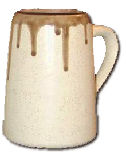 Although not much is said in the description of these cups, there is mentioned of some being metal and others being enameled.
Although not much is said in the description of these cups, there is mentioned of some being metal and others being enameled.
Then he held out his cup again to Cara. "More wine," he said. She refilled the cup. — Hunters of Gor, page 23.
"In most taverns no bottle is brought to the table but the Paga is brought to the table, by the Paga slave, a cup at a time, the cups normally being filled from a vat behind the counter." — Explorers of Gor, page 158.
"Paga," I said. I had smelled the drink… I threw back my head and drained the cup. I held the metal cup in my right hand. — Beasts of Gor, page 141.
"Bera went to the next man, to fill his cup with the mead, from the heavy hot tankard, gripped with cloth, which she carried." — Marauders of Gor, page 78.
"I finished the cup of water and handed the cup back to the water carrier." — Tribesmen of Gor, page 38.
"On the tray, too, was the metal vessel which had contained the black wine, steaming and bitter, from far Thentis, famed for its tarn flocks, the small yellow-enameled cups from which we had drunk the black wine, its spoons and sugars…" — Explorers of Gor, page 10.
Cups, Slave Wine
Here describes a cup, tall and composed of gold, decorated elaborately, which is used by those of Torvald to give bond-maids their slave wine. Most slave cups are made of an inexpensive metal.
Gorm then stood beside Ivar Forkbeard. He carried, on a strap over his shoulder, a tall, dark vessel, filled with liquid. The men on the shore laughed. Attached to the vessel, by a light chain, was a golden cup. It had two handles. From a spout on the vessel, grinning, Gorm filled the golden cup. The liquid swirling in the cup was black. "Drink," said Ivar Forkbeard, thrusting the cup into the hands of the slender, blond girl, she who had, so long ago, in the temple of Kassau, worn the snood of scarlet yarn, with twisted golden wire, the red vest and skirt, the white blouse. She held the cup. It was decorated; about its sides, cunningly wrought, was a design, bond-maids, chained. A chain design also decorated the rim, and, at five places on the cup, was the image of a slave whip, five-strapped. — Marauders of Gor, page 83-84.
Drinking Horn
Curved horn, often with gold filigree, often elaborate, used for the drinking of mead by the men of Torvald. Various drinking horns depicted here.
 |
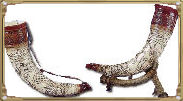 |
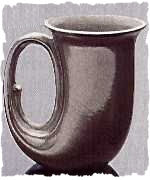 |
I held the large drinking horn of the north. "There is no way for this to stand upright," I said to him, puzzled.
He threw back his head again, and roared once more with laughter. "If you cannot drain it," he said, "give it to another!" — Marauders of Gor, page 89."Mead!" He held out the great, curved horn, with its rim filigreed gold. — Marauders of Gor, page 129.
Flasks
Vessel used for carrying beverages, usually when traveling. 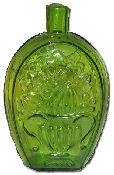 Flasks are made from animal skins, glass and metal, from simple to ornate in design.
Flasks are made from animal skins, glass and metal, from simple to ornate in design.
Etymology: Middle French flasque-, powder flask, ultimately from Late Latin flascon-, flasco bottle, probably of Germanic origin; akin to Old High German flaska-, bottle; Date: 1549:
&nspb;&nsbp;&nsbp;&nsbp;&nsbp; "A container often somewhat narrowed toward the outlet and often fitted with a closure;a broad flattened necked vessel used especially to carry alcoholic beverages on the person." — Merriam-Webster Dictionary © 2003-2006
"I went to his locker near the mat and got out his Ka-la-na flask, taking a long draught myself and then shoving it into his hands. He drained the flask in one drink and wiped his hand across his beard, stained with the red juice of the fermented drink." — Tarnsman of Gor, page 168.
Glasses (Tiny)
Used for Bazi tea and liqueurs.
"She picked up the small tray from the stand near the table. On it was the small vessel containing a thick, sweet liqueur from distant Turia, the Ar of the south, and the two tiny glasses from which we had sipped it." — Explorers of Gor, page 10.
"She lifted the kettle from the fire and, carefully, poured me a tiny glass of tea." — Tribesmen of Gor, page 141.
Goblets
Paga and wine are served in goblets, made of metal usually, often gold and silver.  Goblets are even made from the horn of the bosk.
Goblets are even made from the horn of the bosk.
"I thrust out the silver Paga goblet, studded with rubies, and Telima, standing beside my thronelike chair, filled it. I did not look upon her." — Raiders of Gor, page 223.
"After the meal, I tasted the drink, which might not inappropriately be described as an almost incandescent wine, bright, dry and powerful. I learned later it was called Ka-la-na." — Tarnsman of Gor, page 26.
"My hand clenched on the metal goblet. The wine moved in the vessel."— Tarnsman of Gor, page 30.
"I drained the last sip of the heady wine in the metal goblet." — Tarnsman of Gor, page 34."Bring me a goblet," I said. A goblet was fetched. It was of heavy gold. — Marauders of Gor, page 22.
"Then he took his goblet of Paga and drained it, watching the girls swaying to the caress of Turian melodies." — Nomads of Gor, page 97.
"The proprietor had now returned behind his counter, and was polishing Paga goblets. — Hunters of Gor, page 55.
"Kamchak and I waited until the string had been chewed. When Kamchak had finished he held out his right hand and a man, not a Tuchuk, who wore the green robes of the Caste of Physicians, thrust in his hand a goblet of bosk horn; it contained some yellow fluid." — Nomads of Gor, page 44.
Gourds
Found generally among the Rencers, gourds are carved out, the stems used as plugs, and used for water and other drinking vessels.
"… a gourd of water and a tin of bread and dried bosk meat." — Raiders of Gor, page 2.
"There was another bowl and a cup or two, and two or three gourds." — Raiders of Gor, page 33.
"Then she took a long draught of water from a yellow, curved gourd, and then, thrusting the neck of the gourd into my mouth, gave me a swallow, then drawing it away again and laughing, but then giving it to me again, that I might drink. When I had drunk, she put the plug, carved from gourd stem, back in the gourd, and replaced it in the corner." — Raiders of Gor, page 34.
"I had also been used to carry… strings of water gourds…" — Raiders of Gor, page 41.
"I had carried about bowls of cut, fried fish, and wooden trays of roasted tarsk meat, and roasted gants, threaded on sticks, and rence cakes and porridges, and gourd flagons, many times replenished, of rence beer." — Raiders of Gor, page 44.
"There is usually a water gourd kept at the masthead, for the lookout. I uncorked the gourd and took some of the water." — Raiders of Gor, page 265.
Hydria
On Gor, the hydria is a two-handled vessel used for serving water. 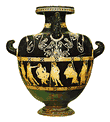 The hydria dates back to the ancient Greeks. Depicted at right: Hydria by the Meidias Painter, c. 410 BC; in the British Museum
The hydria dates back to the ancient Greeks. Depicted at right: Hydria by the Meidias Painter, c. 410 BC; in the British Museum
"Large water vessel in Greek pottery of the Archaic period (c. 750 - c. 480 BC) and the Classical period (c. 480 - c. 330 BC). It is found in both the black-figure and the red-figure pottery styles. The hydria is distinctive in having three handles: a pair of small, horizontal handles at the sides for lifting and a large, vertical handle at the neck or shoulder for dipping and pouring." — Encyclopaedia Romana
Hydria in History
c. 600 BC "Chariots Before the Race" c. 510 BC "Music Lesson" Hydria c. Mid 5th Century BC
"The girls filled their vessels, which, like the hydria, or water vessel, are high-handled, for dipping, in a large kettle hung simmering over a fire near the entrance to the enclosure. Warm Paga makes one drunk quicker, it is thought… Some Cosians tend to be fond of hot Paga." — Vagabonds of Gor, page 16.
Kantharos
The footed bowl used for serving Paga. The kantharos dates back to the early Greek period.
"Also spelled cantharos: — drinking cup in Attic Greek pottery from the period of the red-figure and black-figure styles. The kantharos is in the form of a deep cup, with loop-shaped handles arising from the bottom of the body and extending high above the brim." — Encyclopaedia Romana
Variety of Kantharos
"Achilles and Heroes from the Trojan War" c. 480 BC Kantharos (unknown time period) Aphrodite and Hera depicted
(unknown time period)Kantharos (unknown time period) Archaic Bronze Kantharos, c. 500 BC Archaic Bronze Kantharos Kantharos (unknown time period
"She knelt near the table… and put the Paga, in a small kantharos." — Renegades of Gor, page 71.
Kylix
A footed, shallow drinking bowl of Grecian ancestry.  At left: "Sack of Troy" detail of the Brygos Cup, a kylix decorated by the Brygos Painter, Chuzeville. The Kylix is often elaborated painted on the inside, so that the drinker can gaze upon the beauty of the artwork as he drinks. There is only one quote in the books that mentions a kylix.
At left: "Sack of Troy" detail of the Brygos Cup, a kylix decorated by the Brygos Painter, Chuzeville. The Kylix is often elaborated painted on the inside, so that the drinker can gaze upon the beauty of the artwork as he drinks. There is only one quote in the books that mentions a kylix.
Also spelled Cylix, in ancient Greek pottery, wide-bowled drinking cup with horizontal handles, one of the most popular pottery forms from Mycenaean times through the classical Athenian period. — Encyclopaedia Romana
Designed to be drunk from a reclining position, the cylix was a wide, shallow drinking bowl that the
participants brought to the symposium or which could be kept there. It varied in size and could hold from one half to two liters of wine. The inside of the bowl was particularly well suited for painting, and its flat, round surface (tondo) provided a field for work of more intricate design. The decoration of the cylix usually comprised a band of figures around the outside rim and another composition on the tondo. These two parts often were juxtaposed, one commenting on the other: the outer decoration visible for all to see, the inside more private and revealed to the symposiast only when he had emptied the bowl of its wine. In the cup illustrated here, for example, a happy but drunken comus is depicted, the men dancing to the accompaniment of lyre and flute. On the tondo is depicted its antithetical counterpoint: a participant vomits from too much drink, his head tenderly held by a young hetaira, whose hair is garlanded for the symposium. On the outside rim of another cylix, men negotiate with hetairai; on the tondo inside, a women virtuously offers sacrifice at an altar, the iconography representing the two manifestations of Aphrodite: harlot and hearth keeper. — Encyclopaedia Britannica ©2003-2006
The Kylix
c. 480 BC, "Apollo in Delphi" "Phaethon Son of the Sun Wine" Inside a Cylix c. 470 BC
"He hurled a kylix to the wall." — Magicians of Gor, page 180.
Mead Vessel
A two-handled vessel, usually of bronze, used for serving mead; similar to the hydria most probably.
"Hilda the Haughty, daughter of Thorgard of Scagnar, stripped as any bond-maid, from a large bronze vessel poured mead for the Forkbeard." — Marauders of Gor, page 129.
Paga Vessel
A two-handled vessel, usually of bronze, used for serving Paga; most probably John Norman is referring to a bronze kantharos or kylix. See "Kantharos."
"A few yards away, on the tiles, in her brief silk, the two-handled, bronze Paga vessel beside her, knelt the slave girl, waiting to be summoned." — Hunters of Gor, page 11.
Pitchers
Large serving vessels used for carrying wine. Pitchers can be ceramic or metal in composition, filigreed to bare of design.
Variety of Pitchers
Ceramic Pitcher, Medieval Era Ceramic Pitcher, Medieval Era Metal Pitcher, Medieval Era
"A girl in a tunic of white silk, gracefully, carrying a large pitcher of diluted Ka-la-na wine, approached our table from the rear, and climbed the stairs, delicately, and as though timidly, head down… I glanced at Virginia Kent, who was now moving about the tables, in the incredibly brief silken slave livery, the pitcher on her left shoulder, held there gracefully with her left hand." — Assassin of Gor, pages 186-187.
Skin Bag
Drinking bag made from the skins of animals, usually the verr. These most probably are the bota, but can possibly be flasks as well.
"He leaned over and tossed me a skin bag of Paga, from which I took a long swig, then hurled it contemptuously back into his arms." — Tarnsman of Gor, page 78.
"He signaled to a boy who carried a skin of Ka-la-na wine over his shoulder. He took the skin of wine from the boy and bit out the horn plug; he then, with the wineskin on his shoulder, held back the head of Elizabeth Cardwell with one hand and with the other shoved the bone nozzle of the skin between her teeth; he tipped the skin and the girl, half choking, swallowed wine; some of the red fluid ran from her mouth and over her body. When Kamchak thought she had drunk enough he pulled the nozzle from her mouth, pushed back the plug and returned the skin to the boy. " — Nomads of Gor, pages 39-40.
Talu Bag
A small skin bag carried by nomadic verr herders in the Tahari.
"Water at Klima is generally carried in narrow buckets, on wooden yokes, with dippers attached, for the slaves. A talu is approximately two gallons. A talu bag is a small bag. It is the sort carried by a nomad herding verr afoot in the vicinity of his camp. Bags that small are seldom carried in caravan, except at the saddles of scouts." — Tribesmen of Gor, page 266-267.
Tankard
Generally made of metal, a handled drinking vessel used for ale and black wine.
"… the unmistakable odor of coffee, or as the Goreans express it, black wine. The beans grow largely on the slopes of the Thentis mountains… black wine is far more common on Earth than on Gor, where it is, except for the city of Thentis, a city famed for her tarn flocks, and her surrounding villages, a somewhat rare and unusual luxury… I, grasping the pot with a rag and both hands, poured him a handled, metal tankard of the steaming black brew, coffee or black wine." — Slave Girl of Gor, page 73-74.
"The Forkbeard himself now, from a wooden keg, poured a great tankard of ale, which must have been of the measure of five gallons. Over this he then closed his fist. It was the sign of the hammer, the sign of Thor. The tankard then, with two great bronze handles, was passed from hands to hands among the rowers. The men threw back their heads and, the liquid spilling down their bodies, drank ale. It was the victory ale." — Marauders of Gor, page 82.
Two-Handled Wine Vessel
Two-handled vessel used for serving wine; most likely John Norman refers here to the crater, although in these passages such is not stipulated. See also: "Crater."
Marlenus snapped his fingers, pointing to his cup on the table. The slave girl came forward, from where she knelt to one side, and, kneeling, from a two-handled vessel, filled it. She was very beautiful. "I, too, shall have wine," I said. — Hunters of Gor, page 149.
"He then indicated that she should again kneel to one side, and take up the two-handled wine vessel, that she be ready, when we wished, to serve us once more." — Hunters of Gor, page 153.
Water Bags
Talu bags; utilized by the desert nomads, hung at each side of their kaiila, by which to carry and drink water. See also: "Bota" and "Talu Bag."
"He put his hand on the bulging water bag, which hung behind the saddle, on the left side of the beast, balanced by another on the right. One drinks alternately from the bags, to maintain the weight distribution. Such weight, of course, slows the kaiila, but, in the desert, one must have much water." — Tribesmen of Gor, page 132.
Wineskin
Vessels generally made of verrskin to contain wine. See also: "Bota."
"The drumhead is usually made of verrskin, as most often are wineskins." — Vagabonds of Gor, page 36.
"He signaled to a boy who carried a skin of Ka-la-na wine over his shoulder. He took the skin of wine from the boy and bit out the horn plug; he then, with the wineskin on his shoulder, held back the head of Elizabeth Cardwell with one hand and with the other shoved the bone nozzle of the skin between her teeth; he tipped the skin and the girl, half choking, swallowed wine; some of the red fluid ran from her mouth and over her body." — Nomads of Gor, pages 39-40.
Serving the Drinks
Serving vessels are commonly placed upside down on racks to prevent dust and dirt to collect on them. Woe be it to the slave who dared serve a dirty vessel!!
"Temione had now filled her Paga vessel. She picked up a goblet from a rack near the vat. The shelving on the rack was of narrow wooden rods. The goblets are kept upside down on the rods. In this way, washed, they can drain and dry. This also affords them some protection from dust. I watched her carefully wipe the goblet. Woe to the slave who would dare to serve Paga or wine in a dirty goblet!" — Vagabonds of Gor, page 20.
Pouring Sling
The large, heavy bottles of Paga are often held in slings to better enable the slave girl in pouring the drink into goblets.
"I threw a sliver tarsk, taken from what we had obtained from the slavers in the marsh, to the proprietor of the Paga tavern, and took in return one of the huge bottles of Paga, of the sort you put in a pouring sling…" — Raiders of Gor, page 111.
"The proprietor, when I entered, lifted his head from the counter, behind which hung a great bottle of paga in its pouring sling. I threw down a copper tarn disk and he tilted the great bottle. I took my goblet of paga to a table and sat down, cross-legged, behind it." — Raiders of Gor, page 120.
Tripod
Three-legged stand used to place craters upon so as to heat the wines. 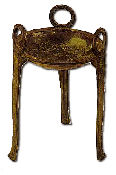 Shown here is a Ritual Libation Tripod, c. 480 BC (Bronze Age).
Shown here is a Ritual Libation Tripod, c. 480 BC (Bronze Age).
"Serve me wine," he said. I turned and, among the furnishings of the tent, found a bottle of Ka-la-na, of good vintage, from the vineyards of Ar, the loot of a caravan raid. I then took the wine, with a small copper bowl, and a black, red-trimmed wine crater, to the side of the fire. I poured some of the wine into the small copper bowl, and set it on the tripod over the tiny fire in the fire bowl… I poured the wine from the small copper bowl into the black, red-trimmed wine crater, placing the small bowl in a rack to one side of the fire. I swirled, slowly, the wine in the wine crater. I saw my reflection in the redness, the blondness of my hair, dark in the wine, and the collar, with its bells, about my throat… I, carrying the wine crater, rose to my feet and approached him. I then knelt before him, with a rustle of slave bells, in the position of the pleasure slave. I put my head down and, with both hands, extending my arms to him, held forth the wine crater. "I offer you wine, Master,' I said. — Captive of Gor, page 311.
Vats
Deep containers utilized by taverns which hold Paga; which is then served in bowls or cups to patrons.
I hurried to the counter and handed Busebius, who was beaming, the Paga vessel and strap. Again it had been emptied. He dipped the vessel into a great vat of Paga and returned it to me. "Paga! Paga!" I heard. I did not even have time to slip the vessel on its strap over my shoulder. Holding its two handles with my hands, I fled back, with a jangle of slave bells, to the floor, to serve. — Slave Girl of Gor, page 298.
Dinnerware and Eating Utensils
Dishes, utensils and other eatingware was commonplace in the cities. Dishes were made of ceramics and metals; eating utensils varied by region. And then there are those cultures who found no need of such amenities:
"He was eating a piece of bosk meat in the Tuchuk fashion, holding He meat in his left hand and between his teeth, and cutting pieces from it with a quiva scarcely a quarter inch from his lips, then chewing the severed bite and then again holding the meat in his hand and teeth and cutting again," — Nomads of Gor, page 186.
Below you will find a list of eating utensils, dinnerware and other amenities mentioned in the books.
Colored Sticks
Most probably the Gorean equivalent of toothpicks; used for serving hor d'oeuvres.
"Saphrar, eyes closed, was nibbling on a tiny thing, still quivering, which had been impaled on a colored stick." — Nomads of Gor, page 86.
Dishware
Dishes were made of ceramics and even precious metals, especially in the houses of the wealthy.
"Before them had been placed large golden dishes heaped with delicacies prepared by the kitchens of the Ubar.." — Nomads of Gor, page 253.
Possible Dishes, Platters and Eating Utensils Used
Medieval Period Metal Plate Set Medieval Feast Metal Plate Set Medieval Period Ceramic Plate and Tankard Medieval Period Metal Platter Medieval Period Forged Eating Set Medieval Period Eating Set
Large Norse Eating Knife Small Norse Eating Knife
Note: The Norse eating knives are possibly similar to those used by the Alars, the four tribes of the Wagon Peoples and the Torvaldslanders.
Golden Eating Prong
Eating utensil made of gold; indigenous to Turia.
"It is the spiced brain of the Turian vulo," Saphrar was explaining… I shot the spiced vulo brain into my mouth on the tip of a golden eating prong, a utensil, as far as I knew, unique to Turia. — Nomads of Gor, page 83.
Napkins
Although a slave's hair may be used as a napkin for a free, the finer houses did emply the use of cloth napkins.
"… and the softened, dampened cloths on which we had wiped our fingers." — Explorers of Gor, page 10.
Cooking Methods and Vessels
Braziers and Fire Bowls
Shallow bowls made of copper with a raised brass grating; used by such people as the wagon peoples, 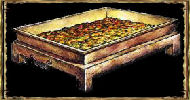 as well as travelers, to cook as well as furnish heat and heat branding irons.
as well as travelers, to cook as well as furnish heat and heat branding irons.
Etymology: French brasier, from Old French, fire of hot coals, from breze hot coals; Date: 1658
1 : a pan for holding burning coals
2 : a utensil in which food is exposed to heat through a wire grill — Merriam-Webster Dictionary ©2004-2006
"In the center of the wagon there is a small, shallow fire bowl, formed of copper, with a raised brass grating. Some cooking is done here, though the bowl is largely to furnish heat." — Nomads of Gor, page 31.
"I decided I might care to taste the steaming, black wine. I lifted my finger. The girl in whose charge was the silver vessel, filled with black wine, knelt beside a tiny brazier, on which it sat, retaining its warmth. Seeing my signal, she stiffened; she hesitated. She was white, dark-haired. She wore a high, tight vest of red silk, with four hooks; her midriff was bare; she wore the sashed chalwar, a sashed, diaphanous trousered garment, full but gathered in, closely, at the ankles; she was barefoot; her wrists and ankles were bangled; she was veiled; she was collared. She rose swiftly to her feet. She knelt, head down, before me. She poured, carefully, the hot, black beverage into the tiny red cup. I dismissed her. Beneath her veil I had not been able to read the lettering on her collar, which would tell who owned her. I supposed it was Suleiman, since she was serving in the palace. The other girl, the white-skinned, red-haired girl, also in vest, chalwar and veil, and bangles and collar, lifted her tray of spoons and sugars. But I turned away. She was not summoned. The girls, white-skinned, were a matched set of slaves, one for the black wine, one for its sugars." — Tribesmen of Gor, page 105.
"Nearby, on a large, flat stone, to keep it from sinking into the ground, was the anvil. A few feet away, glowing with heat, stood two canister braziers. In these, among the white coats, were irons." — Marauders of Gor, page 86.
Kettles and Pots, Cooking
Made of heavy metals of various types; used for cooking foods and heating beverages.
"Tuchuk women, unveiled, in their long leather dresses, long hair bound in braids, tended cooking pots hung on tem-wood tripods over dung fires." — Nomads of Gor, page 27.
"The girls filled their vessels, which, like the hydria, or water vessel, are high-handled, for dipping, in a large kettle hung simmering over a fire near the entrance to the enclosure." — Vagabonds of Gor, page 16.
"She lifted the kettle from the fire and, carefully, poured me a tiny glass of tea." — Tribesmen of Gor, page 141.
Ladles
A deep-bowled long-handled spoon especially for dipping up and conveying liquids. Ladles are generally made of brass and wood. Ladles among the rencers are made of the wood of the rence root.
"There was a brass ladle that Aphris and Elizabeth had used in cooking …" — Nomads of Gor, page 267.
"There was another bowl and a cup or two, and two or three gourds. Some utensils were in the bowl, a wooden stirring stick and a wooden ladle, both carved from rence root." — Raiders of Gor, page 33.
Metal Racks
Used by rence growers to support the metal pans used to hold fires so as to roast meats. See: "Metal Roasting Pans."
"Before the feast I had helped the women, cleaning the fish and dressing marsh gants, and then, later, turning spits for the roasted tarsks, roasted over rence-root fires kept on metal pans, elevated about the rence of the island by metal racks, themselves resting on larger pans." — Raiders of Gor, page 44.
Metal Roasting Pans
Mentioned in regards to the rence growers, these large pans are used as a form of a very large barbecue. Because the rence islands are highly flammable, cooking poses a problem. Therefore, these large pans are placed upon metal racks (which rest on larger metal pans) and used in the roasting of tarsk and gant over rence-root fires. The meat then is suspended with the aid of spits and turned over these fires.
"Before the feast I had helped the women, cleaning the fish and dressing marsh gants, and then, later, turning spits for the roasted tarsks, roasted over rence-root fires kept on metal pans, elevated about the rence of the island by metal racks, themselves resting on larger pans." — Raiders of Gor, page 44.
Mortar and Pestle
Grinding bowl and utensil for grinding flour and other grains. Shown here is a mortar and pestle from the Medieval Period. Most Sa-Tarna grain is commercially ground into flour at large mills using large querns. 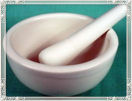 Please see: "Quern."
Please see: "Quern."
Etymology:Middle English morter, from Old English mortere & Middle French mortier, from Latin mortarium mortar, vessel in which substances are pounded or rubbed, plastic building material that hardens and is used in masonry, trough in which mortar is mixed; akin to Greek marainein to waste away;
"A small usually bowl-shaped vessel made of a hard material (as stone, porcelain or brass) in which substances are pounded or rubbed with a pestle." —Merriam-Webster Dictionary ©2003-2006Etymology:Middle English pestel, from Middle French, from Latin pistillum; akin to Middle Low German visel pestle, Latin pilum pestle, javelin, pinsere to pound, crush, Greek ptissein to crush, Sanskrit pinasti he pounds, crushes;
"A usually club-shaped implement for pounding or grinding substances especially in a mortar; any of various devices for pounding, stamping, or pressing." —Merriam-Webster Dictionary ©2003-2006
"The heavy, round-ended pestle some five feet in height, more than five inches wide at the base, dropped. It weighed some thirty pounds. When it dropped, the heavy wooden bowl, more than a foot deep and eighteen inches in diameter tipped. Sa-Tarna grain spilled to the ground." — Tribesmen of Gor, pages 136-137.
Quern
An ancient device for the grinding of grain into flour. Most Sa-Tarna grain is commercially ground into flour at large mills using large querns, made of large stones, turned generally by water power, but also, at times, by male slaves, or tharlarion. Females cannot turn these large querns. In the smaller villages, a smaller version of the quern, somewhat akin to the mortar and pestle, is used, however, this type of quern is operated by men or boys, depending on the size of the quern. A smaller, hand-held quern in which a female can operate, uses a similar principal, but turned with a wooden handle.
Etymology:Middle English, from Old English cweorn; akin to Old High German quirn, quirna hand mill, millstone,
Old Norse kvern hand mill, Gothic -qairnus millstone, Old Irish brau millstone, Old Slavic zruny mill, and probably to Gothic kaurjos (nominative plural) heavy;
"1) A primitive mill for grinding grain consisting of two circular stones with the upper one being turned by hand;
2) a small hand mill (as for grinding spices or nuts)." — Merriam-Webster Dictionary ©2004-2006"An ancient device for grinding grain. The saddle quern, consisting simply of a flat stone bed and a rounded stone to be operated manually against it, dates from Neolithic times (before 5600 BC). The true quern, a heavy device worked by slave or animal power, appeared by Roman times. Cato the Elder describes a 2nd-century-BC rotary quern consisting of a concave lower stone and a convex upper, turned by a pair of asses. Many such large querns were found in the ruins of Pompeii. The upper stone was set on a spindle that fitted into the lower. The ground grain passed down through holes in the lower stone." — Encyclopaedia Britannica ©2004-2006
"This was a reference to an old form of grinding, for some reason still attributed to Priest-Kings, in which a pestle, striking down, is used with a mortar. Most Sa-Tarna is now ground in mills, between stones, the top stone usually turned by water power, but sometimes by tharlarion, or slaves. In some villages, however, something approximating the old mortar and pestle is sometimes used, the two blocks, a pounding block strung to a springy, bent pole, and the mortar block, or anvil block. The pole has one or more ropes attached to it, near its end. When these are drawn downward the pounding block descends into the mortar block, and the springiness of the pole, of course, straightening, then raises it for another blow. More commonly, however, querns are used, usually, if they are large, operated by two men, if smaller, by two boys. Hand querns, which may be turned by are a woman, are also not unknown. The principle of the common quern is as follows: it consists primarily of a mount, two stones, an overhead beam and a pole. The two stones are circular grinding stones. The bottom stone has a small hub on its upper surface which fits into an inverted concave depression in the upper stone. This helps to keep the stones together. It also has shallow, radiating surface grooves through which the grindings may escape between the stones, to be caught in the sturdy boxlike mount supporting the stones, often then funneled to a waiting receptacle or sack. The upper stone has two holes in it, in the center a funnel-shaped hole through which grain is poured, and, near the edge, another hole into which one end of the turning pole is placed. This pole is normally managed by two operators. Its upper portion is fitted into an aperture in the overhead beam, which supplies leverage and, of course, by affording a steadying rest, makes the pole easier to handle. The principle of the hand quern is similar, but is usually turned with a small wooden handle. The meal or flour emerging from these devices is usually sifted, as it must often be reground, sometimes several times. The sifter usually is made of hide stretched over a wooden hoop. The holes are punched in the hide with a hot wire." — Renegades of Gor, pages 17-18.
Roasting Spits
Mentioned in regards to the rence growers, used in the roasting of tarsk and gant over rence-root fires.
"Before the feast I had helped the women, cleaning the fish and dressing marsh gants, and then, later, turning spits for the roasted tarsks, roasted over rence-root fires kept on metal pans, elevated about the rence of the island by metal racks, themselves resting on larger pans." — Raiders of Gor, page 44.
Serving Trays
Serving trays are made of either metal or wood, depending on region and culture.
"I had carried about bowls of cut, fried fish, and wooden trays of roasted tarsk meat, and roasted gants, threaded on sticks, and rence cakes and porridges, and gourd flagons, many times replenished, of rence beer." — Raiders of Gor, page 44.
Spoons, Stirring
Small spoons used for stirring sugars and other spices.
"… the small bowls of spices and sugars with their stirring spoons at hand." — Nomads of Gor, page 253.
Sticks, Stirring
Found among the rencers, these sticks made of the wood of the rence plant are used for stirring.
"There was another bowl and a cup or two, and two or three gourds. Some utensils were in the bowl, a wooden stirring stick and a wooden ladle, both carved from rence root." — Raiders of Gor, page 33.
Tin Boxes
Used for storage, usually of spices and sugars.
"… and a tin box of yellow Turian sugar…" — Nomads of Gor, page 267.
Tripods
Made of tem-wood generally; cooking pots can be hung over fires. 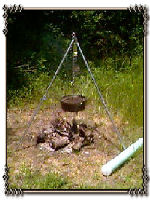 Pictured here is a more modern version made of metal, but the concept is the same.
Pictured here is a more modern version made of metal, but the concept is the same.
"Tuchuk women, unveiled, in their long leather dresses, long hair bound in braids, tended cooking pots hung on tem-wood tripods over dung fires." — Nomads of Gor, page 27.
Warming Stones
I have often seen in virtual chat rooms, the mention of "warming stones" when a slave girl serves. There is no mention of "warming stones" in the books. Perhaps, through the many misinterpretations — and misinformation — from the books, the braziers of the Wagon Peoples became the "warming stones" of virtual chat rooms.
"In the center of the wagon there is a small, shallow fire bowl, formed of copper, with a raised brass grating. Some cooking is done here, though the bowl is largely to furnish heat." — Nomads of Gor, page 31.
![]()
Special Note
Because of the differences in publishing the books, depending upon whether published in the U.S. or Europe, depending upon whether a first publishing or a Masquerade Books release, page numbers will often vary. All of my quotes are from original, first-printing U.S. publications (see The Books page for a listing of publishers and dates) with the exception of the following books:
- Tarnsman of Gor (2nd Printing, Balantine)
- Outlaw of Gor (11th Printing, Balantine)
- Priest-Kings of Gor (2nd Printing, Balantine)
- Assassin of Gor (10th Printing, Balantine)
- Raiders of Gor (15th Printing, Balantine)
- Captive of Gor (3rd Printing, Balantine)
Disclaimer
These pages are not written for any specific home, but rather as informational pages for those not able to get ahold of the books and read them yourself. Opinions and commentaries are strictly my own personal views, therefore, if you don't like what you are reading — then don't. The information in these pages is realistic to what is found within the books. Many sites have added information, assuming the existences of certain products and practices, such as willowbark and agrimony for healing, and travel to earth and back for the collection of goods. I've explored the books, the flora, the fauna, and the beasts, and have compiled from those mentioned, the probabilities of certain practices, and what vegetation mentioned in the books is suitable for healing purposes, as well as given practicalities to other sorts of roleplaying assumptions.
